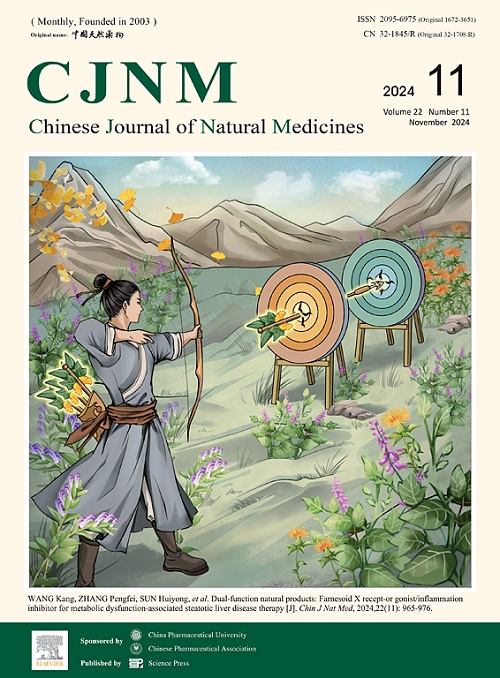新型皂苷-三唑衍生物在脂肪形成调控中的设计与合成
IF 4.9
2区 医学
Q1 INTEGRATIVE & COMPLEMENTARY MEDICINE
引用次数: 0
摘要
与三七(P. notoginseng)相关的皂苷在多种疾病中显示出显着的治疗功效。然而,由于某些高产皂苷的药理作用降低,其临床应用受到限制。本研究合成了36种人参皂苷Rg1/Rb1和三七皂苷R1的皂苷-1,2,3-三唑衍生物,并对其体外抗脂肪生成活性进行了评价。研究发现人参皂苷rg1 -1,2,3-三唑衍生物a17具有良好的脂肪生成抑制作用。结构-活性关系分析表明,通过Click反应在皂苷侧链中加入氨基取代的1,2,3-三唑可增强抗脂肪生成活性。此外,其他几种衍生物表现出普遍的脂肪生成抑制作用。与母体人参皂苷Rg1相比,化合物a17的效力增强。机制研究表明,a17在体外表现出剂量依赖性的脂肪形成抑制,并伴有前脂肪细胞表达降低。过氧化物酶体增殖物激活受体γ (PPARγ),脂肪酸合成酶(FAS)和脂肪酸结合蛋白4 (FABP4)脂肪形成调节剂。这些发现证实了人参皂苷rg1 -1,2,3-三唑衍生物a17是一种有前景的脂肪细胞分化抑制剂和潜在的治疗肥胖和相关代谢紊乱的药物。本研究为开发各种代谢综合征的有效治疗方法提供了基础。本文章由计算机程序翻译,如有差异,请以英文原文为准。
Design and synthesis of novel saponin-triazole derivatives in the regulation of adipogenesis
Saponins associated with Panax notoginseng (P. notoginseng) demonstrate significant therapeutic efficacy across multiple diseases. However, certain high-yield saponins face limited clinical applications due to their reduced pharmacological efficacy. This study synthesized and evaluated 36 saponin-1,2,3-triazole derivatives of ginsenosides Rg1/Rb1 and notoginsenoside R1 for anti-adipogenesis activity in vitro. The research revealed that the ginsenosides Rg1-1,2,3-triazole derivative a17 demonstrates superior adipogenesis inhibitory effects. Structure-activity relationships (SARs) analysis indicates that incorporating an amidyl-substituted 1,2,3-triazole into the saponin side chain via Click reaction enhances anti-adipogenesis activity. Additionally, several other derivatives exhibit general adipogenesis inhibition. Compound a17 demonstrated enhanced potency compared to the parent ginsenoside Rg1. Mechanistic investigations revealed that a17 exhibits dose-dependent inhibition of adipogenesis in vitro, accompanied by decreased expression of preadipocytes. Peroxisome proliferator-activated receptor γ (PPARγ), fatty acid synthase (FAS), and fatty acid binding protein 4 (FABP4) adipogenesis regulators. These findings establish the ginsenoside Rg1-1,2,3-triazole derivative a17 as a promising adipocyte differentiation inhibitor and potential therapeutic agent for obesity and associated metabolic disorders. This research provides a foundation for developing effective therapeutic approaches for various metabolic syndromes.
求助全文
通过发布文献求助,成功后即可免费获取论文全文。
去求助
来源期刊

Chinese Journal of Natural Medicines
INTEGRATIVE & COMPLEMENTARY MEDICINE-PHARMACOLOGY & PHARMACY
CiteScore
7.50
自引率
4.30%
发文量
2235
期刊介绍:
The Chinese Journal of Natural Medicines (CJNM), founded and sponsored in May 2003 by China Pharmaceutical University and the Chinese Pharmaceutical Association, is devoted to communication among pharmaceutical and medical scientists interested in the advancement of Traditional Chinese Medicines (TCM). CJNM publishes articles relating to a broad spectrum of bioactive natural products, leading compounds and medicines derived from Traditional Chinese Medicines (TCM).
Topics covered by the journal are: Resources of Traditional Chinese Medicines; Interaction and complexity of prescription; Natural Products Chemistry (including structure modification, semi-and total synthesis, bio-transformation); Pharmacology of natural products and prescription (including pharmacokinetics and toxicology); Pharmaceutics and Analytical Methods of natural products.
 求助内容:
求助内容: 应助结果提醒方式:
应助结果提醒方式:


